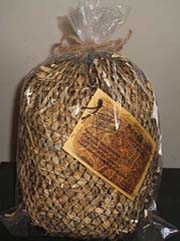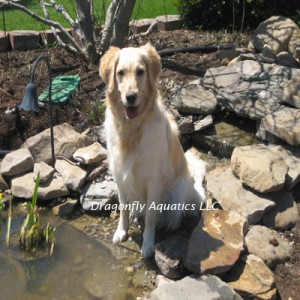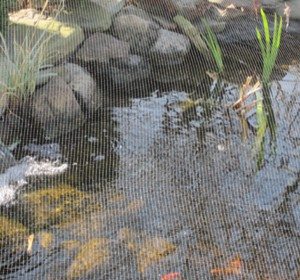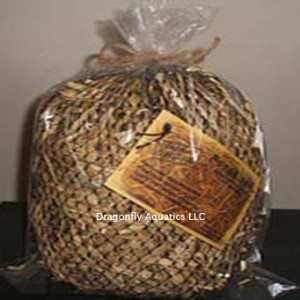 Barley is a natural approach to eliminating string algae, improving water clarity and naturally balancing pond water. Barley is one of the few pond additives that will work at any temperature.
Barley is a natural approach to eliminating string algae, improving water clarity and naturally balancing pond water. Barley is one of the few pond additives that will work at any temperature.
Barley is available in three different forms. The Barley bale, once placed in your pond, will slowly decompose and as it does so, it will release gases that aid in the elimination of string algae. One 8 oz. bale will treat an 800 to 1200 gallon pond. It will take several weeks for the barley to start decomposing and will continue to work for about 3 months. Microbe-Lift Barley Straw Pellets will break down faster than the bales, plus they are rich in organic peat which softens pond water, reducing the negative effect of phosphate and generally improving the environment for your fish. Two pounds of barley pellets will treat a 400 gallon pond for 4 months. Last, but not least, and my favorite is the Microbe-Lift Barley Straw Extract. The extract goes to work on contact. Decomposition starts immediately and one bottle is equal to a multiple of barley straw bales.
Barley will not kill algae, but it will prohibit it from growing and help eliminate it from your water garden. When the water temperatures are still cool, this is one product that will immediately go to work for you.
 Time to spring forward, or at least turn the clocks forward! Things are beginning to warm up a bit here in the north and we are anxiously waiting for Spring to arrive so we can begin to add new plants to our ponds. Another couple of months and we will be sitting back enjoying our ponds once again. It won't be long now. For those in the warmer regions, zones 8 and above, you are putting pond plants in your ponds and starting to enjoy them, while those of us in the lower zones are still waiting. At least most of the ice has melted and we can begin thinking about our ponds once again.
Time to spring forward, or at least turn the clocks forward! Things are beginning to warm up a bit here in the north and we are anxiously waiting for Spring to arrive so we can begin to add new plants to our ponds. Another couple of months and we will be sitting back enjoying our ponds once again. It won't be long now. For those in the warmer regions, zones 8 and above, you are putting pond plants in your ponds and starting to enjoy them, while those of us in the lower zones are still waiting. At least most of the ice has melted and we can begin thinking about our ponds once again.
Don't be fooled by Mother Nature. We need to make sure it is warm enough outside, and make sure our pond water is warm enough for the plants to survive. Knowing your pond temperature is crucial, so begin by checking your pond water temperature at different times of the day. The pond water is cooler in the morning and warmer in the afternoon but will cool down again in the evening. Knowing what the consistant temperature of your pond water is important before adding the pond plants.
The first plants most of us want to put in are those that will help us keep the pond clear, such as floating plants like water hyacinths and water lettuce. Cold water will kill both of these in a matter of days if the water temperature is still too cold. We need to make sure the water temperature is consistent and reaches 65 degrees and stays there morning, afternoon and evening before we add floating plants.
There are other things we must do first that will keep us busy, such as adding beneficial bacteria to help keep our pond clear. The good bacteria, such as MicrobeLift PL neutralizes ammonia and nitrites, and will start to work when the water temperature are 50-55 degrees. If you add bacteria, it will stay in the pond and start working when the pond water is warm enough. It acts on its own and will stay un-activated until it knows to start working. For those of us who use barley, now is the right time to start adding it. This will also help retard the growth of string algae in the Spring months.
The list goes on and on. While all of us are anxious to add the pond plants there are still several things to do prior to this. I will be posting articles in the next few days with spring tips for our ponds.
Stay tuned!
 I hope everyone enjoyed their Thanksgiving with family and friends, and of course, a delicious meal.
I hope everyone enjoyed their Thanksgiving with family and friends, and of course, a delicious meal.
I finally put all my plants to bed for the winter and covered the pond. It looks bare, but the fish all seem happy, even with the cooler water. It has been a long fall, so we have been lucky so far. Normally this time of year, we have already had our first snow and temperatures well below 40 degrees. Daytime temperatures have been averaging around 45 degrees to 55 degrees, with a bit more sun then Ohio usually sees, this time of year. Lucky so far, but what will winter bring.....
A couple of weeks ago, I noticed I had a few lilies starting to get green, Aquatic For-Get-Me Nots still blooming and Cannas that refuse to die back so I can store them for the winter......they all must be a bit confused. Snow and more seasonable temperatures are forecast for the end of this week, that should send the rest of the plants, that have been hanging on into dormancy.
I read an interesting article about algae that I thought I'd share. It mentioned putting barley straw in your pond during the winter to help control algae. I put a couple barley bundles in my pond, to see if it makes a difference in the spring. Water gardeners will do almost anything to keep that nasty algae from growing. As soon as temperatures begin to warm in the spring, before the water lilies send up their first few leaves, the algae seems to re-appear on the waterfalls, sides of the pond and in the stream beds. Barley does not kill algae, it prohibits it from growing. From everything I have read, and talking to customers that use either the barley bundles, barley extract or barley straw pellets, it does the trick! Next spring....hopefully no more algae!
 As water temperatures cool, algaecides such as PondCare Algaefix, Microbe-Lift Algaeway and Green Clean are less effective. Adding Microbe-Lift Barley Straw Extract or Barley Straw Bundle will help control string algae throughout the fall and winter months. Microbe-Lift Barley Straw Extract, Microbe-Lift Barley Straw Pellets or Barley Straw bundles are an effective and eco-friendly way to reduce algae.
As water temperatures cool, algaecides such as PondCare Algaefix, Microbe-Lift Algaeway and Green Clean are less effective. Adding Microbe-Lift Barley Straw Extract or Barley Straw Bundle will help control string algae throughout the fall and winter months. Microbe-Lift Barley Straw Extract, Microbe-Lift Barley Straw Pellets or Barley Straw bundles are an effective and eco-friendly way to reduce algae.
Purchase MicrobeLift Barley Straw, Barley Bundles, Barley Pellets here.